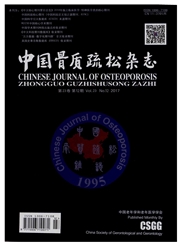

 中文摘要:
中文摘要:
破骨细胞从起源发育至成熟,再经活化发挥吸收作用是一个复杂的多级调控过程,始终都受到一系列细胞因子的影响。有些细胞因子对破骨细胞的成熟分化起促进作用,如:RANKL、TNF-α、IL-1、IL-6、1,25-(OH)2D3、PTH、M-CSF等,其中RANKL和M-CSF是破骨细胞形成和分化过程中的两个必需的因子;有些因子起抑制作用,如:OPG、IL-4、IL-10、雌激素、降钙素、TGF-β等。OPG/RANK/RANKL系统在破骨细胞分化成熟过程中起着枢纽作用,大部分细胞因子都直接或间接地通过OPG/RANK/RANKL系统来发挥作用,其中还涉及到成骨细胞、破骨细胞、基质细胞等复杂的相互作用。介导破骨细胞分化成熟的各种细胞因子反应的信号传导路径主要包括MAPK、NF-kappaB、CN/NFAT等通路,全面地了解破骨细胞因子及其信号传导通路,将有助于临床更好地分析各种骨代谢性疾病的病因及发病机制,进而为治疗提供理论依据。
 英文摘要:
英文摘要:
It is a complicated process that osteoclast differentiates from progenitor to mature osteoclast which have the function of bone resorption. There are series of cytokines and systemic hormones involved in this phase. Some cytokines promote osteoclast development, such as RANKL, TNF-α, IL-1, I L-6,1,25- ( OH )2 Ds, PTH, M-CSF, and the list will go on, in which RANKL and M-CSF are essential. Other cytokines inhibit osteoclast growth, such as OPG, IL-4, IL-IO, estrogen, calcitonin, TGF-β, and so on. The OPG/RANK/RANKL system is vital in the period. Most of cytokines play role through OPG/RANK/RANKL system directly or indirectly. The interaction between osteoclast and osteoblast or stromal cell is also important. There are several signal pathways such as MAPK, NF- kappaB and CN/NFAT, involved in osteoclast differentiation. Understanding the cytokines of osteoclast and path of signal transduction respectively make it possible for us to comprehend the development and the treatment of the bone metabolic diseases.
 同期刊论文项目
同期刊论文项目
 同项目期刊论文
同项目期刊论文
 期刊信息
期刊信息
